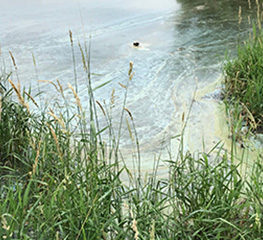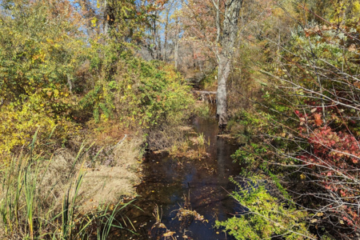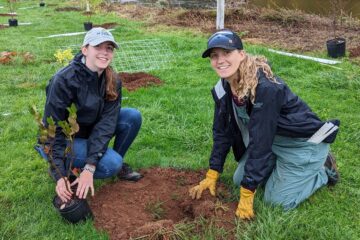 It’s a recipe for water disaster: Take the increased rainfall of New Jersey’s changing climate and add excessive use of lawn and garden fertilizers. When storms wash these “nutrients” into streams, conditions become ripe for an algae bloom in stream-fed lakes and reservoirs.
It’s a recipe for water disaster: Take the increased rainfall of New Jersey’s changing climate and add excessive use of lawn and garden fertilizers. When storms wash these “nutrients” into streams, conditions become ripe for an algae bloom in stream-fed lakes and reservoirs.
According to watershed watchdog Raritan Headwaters Association (RHA), that’s exactly what’s happening in Lake Hopatcong, New Jersey’s largest lake, and in Spruce Run Reservoir, the state’s third largest water supply reservoir and also a popular swimming and boating spot.
The state Department of Environmental Protection shut down public swimming areas at Spruce Run and Lake Hopatcong due to a bloom of toxic blue-green algae – also known as cyanobacteria – and warned against any contact with the water. The DEP also warned residents to not eat fish from Spruce Run or Lake Hopatcong, or let their pets swim in or drink from the waters.
Touching algae-infested water can cause a skin rash or allergic-type reactions. If water is consumed, health officials say it can cause abdominal pain, headaches, vomiting, nausea, blistering around the mouth and flu-like symptoms.
“This is a wake-up call,” said Cindy Ehrenclou, executive director of the Bedminster-based Raritan Headwaters. “People need to understand that everything we do on the land affects water quality. Manmade chemicals and nutrients that we put on the landscape are being carried through stormwater into our rivers and lakes, and harmful algae blooms are on the rise.”
Bill Kibler, RHA’s policy director, said the Spruce Run and Hopatcong closings illustrate the connection between fertilizer use, stormwater runoff and lake water quality.
“Algae blooms are a direct function of stormwater runoff,” Kibler said. “If you fertilize your lawn and it rains that day, it’s all going to end up in a stream. Algae blooms are fed by fertilizers, just like crops and grass are.” The problem, he added, is exacerbated by animal waste and faulty septic systems.
“This is a very serious issue,” Kibler said. “As long as it keeps raining, these algae blooms will keep happening unless we do something about it.”
“With our changing weather patterns, New Jersey is getting so much more rain than it used to,” added Dr. Kristi MacDonald, RHA’s science director. Climate experts expect this trend to continue in the future, she noted.
What can be done to prevent harmful algae blooms? Plenty, according to Raritan Headwaters, which for 60 years has worked to protect clean water in the upper Raritan River watershed.
Under a new state law – advocated by Raritan Headwaters – municipalities and groups of communities now have the authority to establish stormwater utilities. These utilities can charge fees to commercial and residential developments that cause polluting stormwater runoff. The fees will be used to finance “green infrastructure” projects to control stormwater runoff.
Community and school groups can initiate their own green infrastructure projects to stop stormwater runoff pollution. For example, a group of students teamed up with Dr. Chris Obropta of Rutgers University to build two rain gardens at the Bridgewater Middle School; they’re now planning to continue their project at Bridgewater-Raritan High School. Rain gardens slow the flow of stormwater, allowing the ground time to filter pollutants out of the water.
“This summer’s lake closings are a result of poor practices, past and current. It’s time to be proactive in our homes and communities to collectively protect the health of water for swimming, fishing and most importantly drinking,” said Ehrenclou.
Individual residents can help protect water quality in many ways, according to Ehrenclou:
- Use fewer chemical fertilizers and pesticides
- Pick up and dispose of dog waste
- Inspect and maintain home septic systems
- Properly store farm animal manure
- Don’t feed wild geese that congregate around ponds and riverbanks
- Maintain vegetated buffers around streams and ponds
- Install green infrastructure like rain gardens to filter runoff water
To learn more about harmful algal blooms and how to report a suspected bloom, go to the Department of Environmental Protection website.
About Raritan Headwaters
Raritan Headwaters has been working since 1959 to protect, preserve and improve water quality and other natural resources of the Raritan River headwaters region through efforts in science, education, advocacy, land preservation and stewardship. RHA’s 470-square-mile region provides clean drinking water to 300,000 residents of 38 municipalities in Somerset, Hunterdon and Morris counties and beyond to some 1.5 million homes and businesses in New Jersey’s densely populated urban areas.
Raritan Headwaters regularly organizes workshops and seminars to teach the pubic and municipal leaders how to protect water quality. Recent workshops have focused on stormwater runoff, green infrastructure and how local communities can become more resilient to the impacts of climate change.
Raritan Headwaters is accredited by the national Land Trust Accreditation Commission, meaning it has been recognized as a strong and effective organization committed to professional excellence and maintaining the public’s trust.
To learn more about Raritan Headwaters and its programs, please visit www.raritanheadwaters.org or call 908-234-1852.



